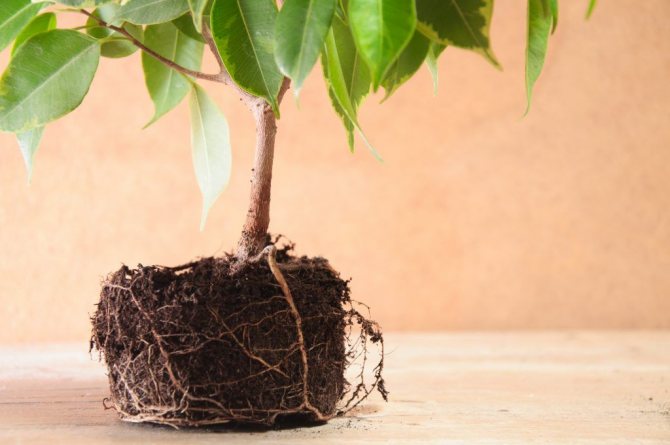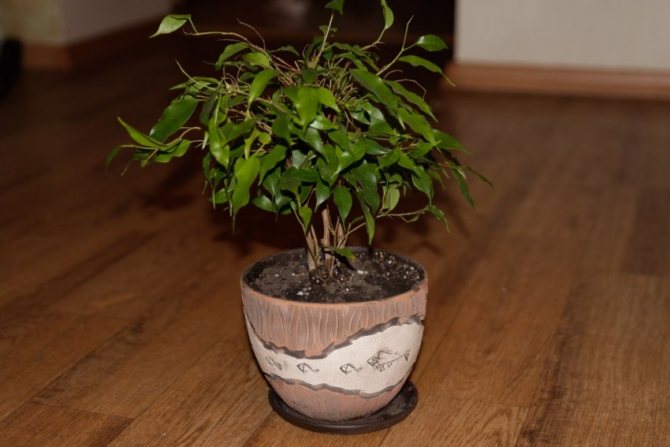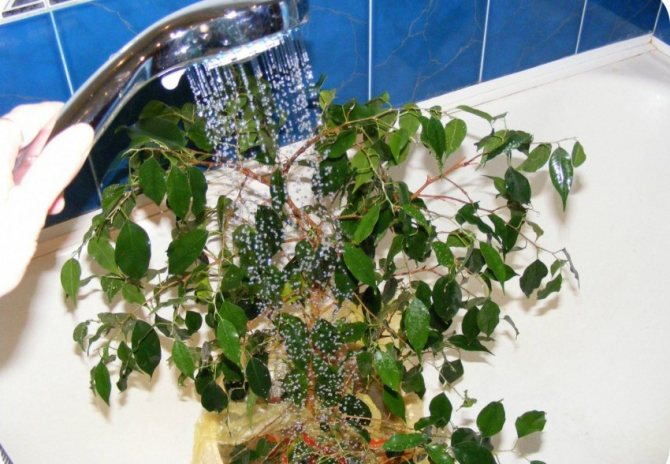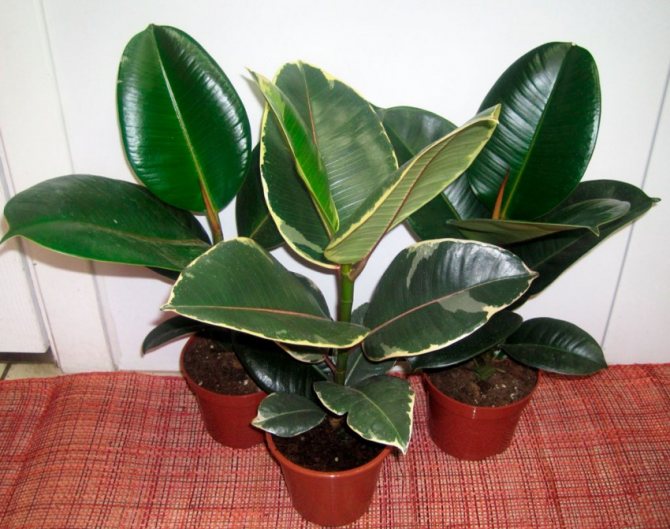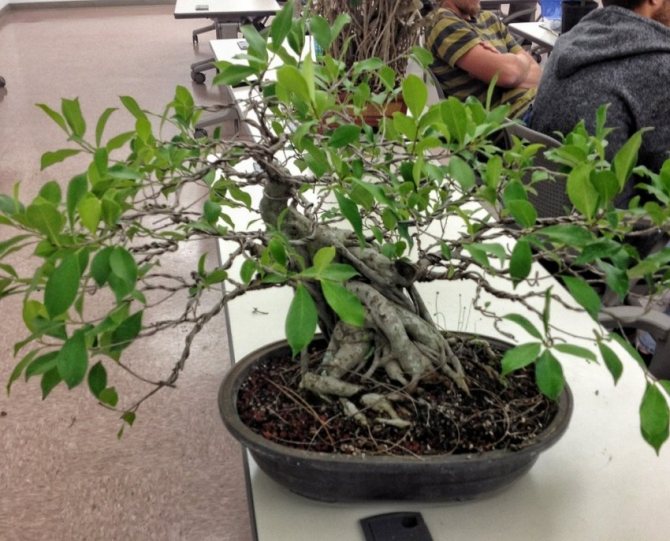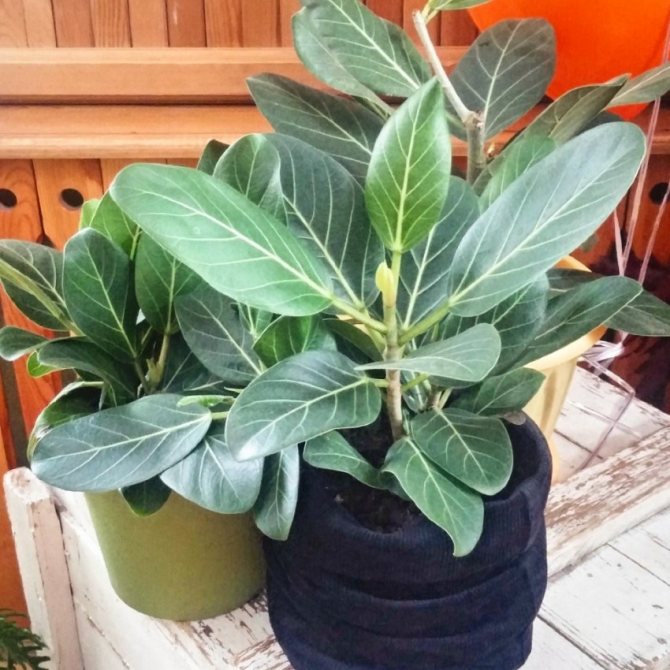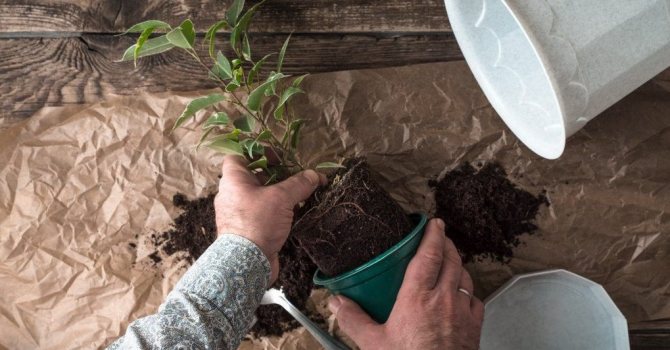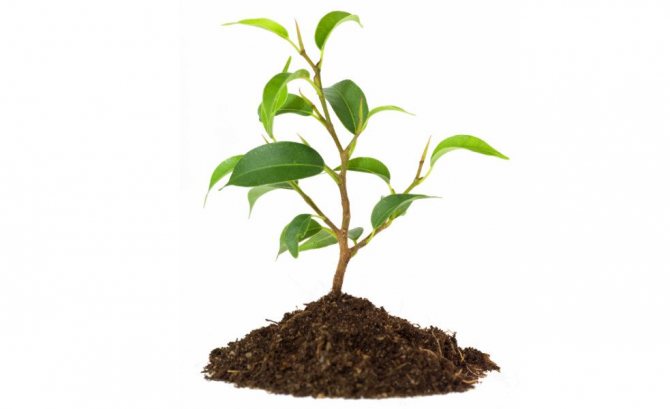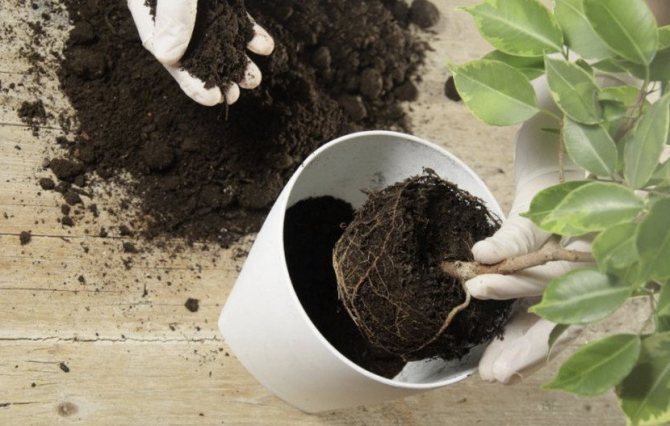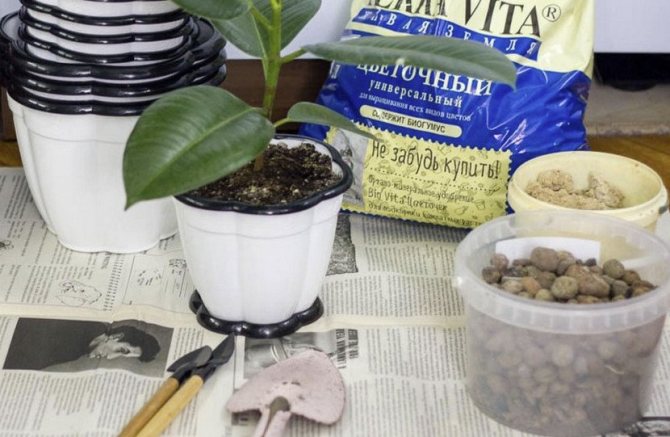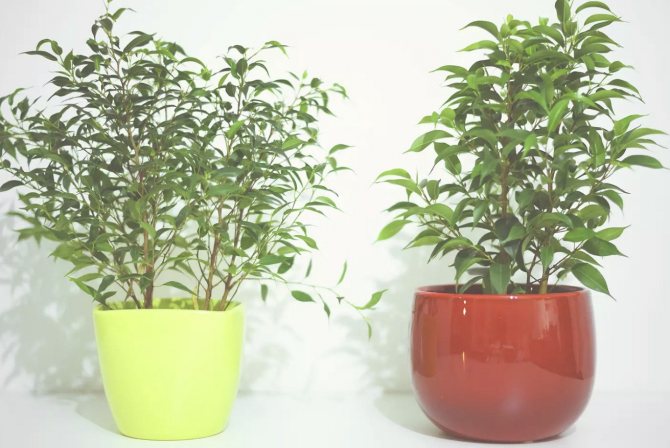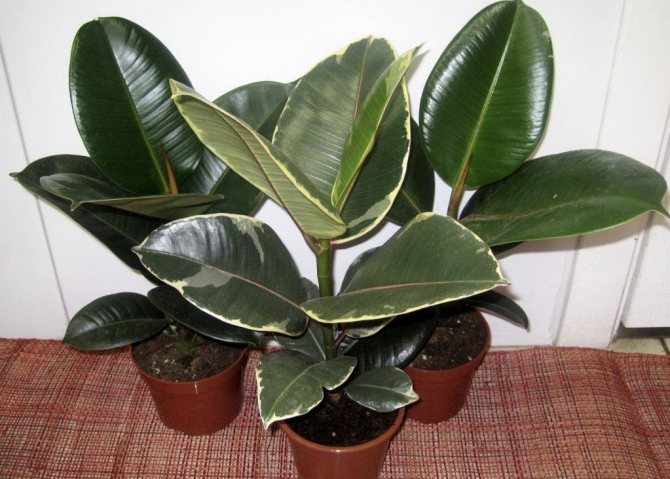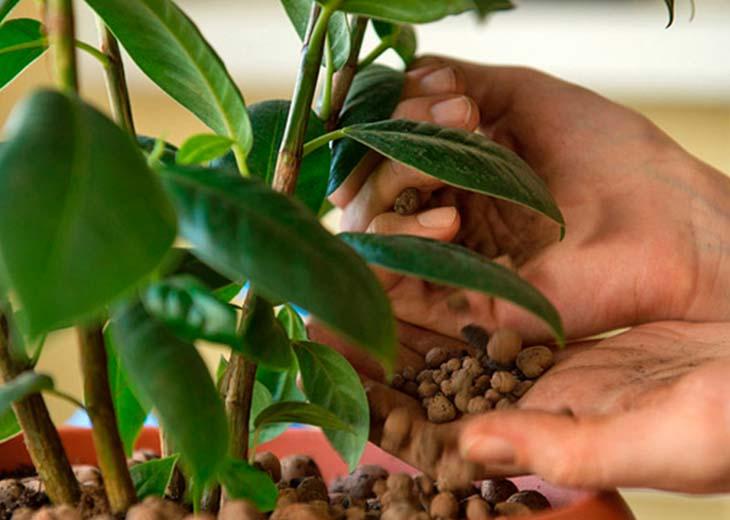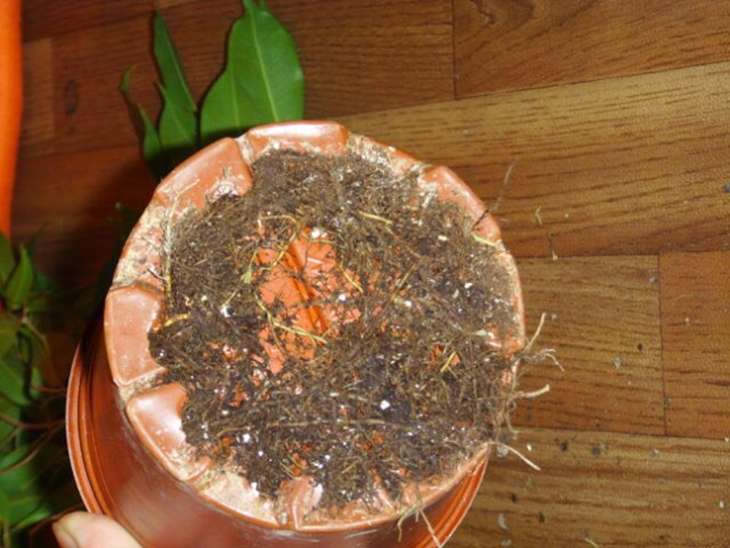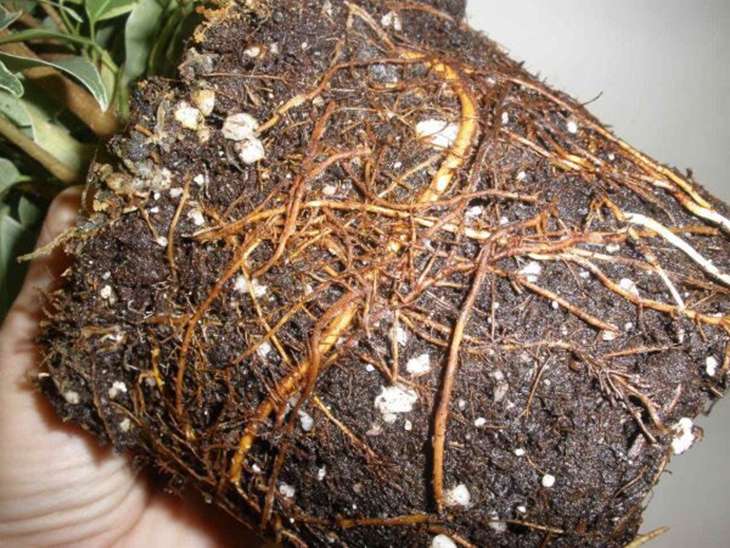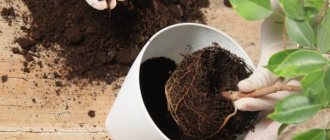An evergreen bushy tree - Benjamin's ficus - has long been popular as an interior decoration. Its lush crown does an excellent job of its decorative role.
Breeders have bred so many varieties of Benjamin that all can not be remembered.
I bought my ficus (Kinky variety) at the flower market. It attracted my attention by the fact that even then it looked like a small tree, although it barely reached 10 cm in height. And I have a weakness for such tree-like dwarf plants, similar to bonsai.
By the way, Benjamin's ficus is ideal for bonsai formation. I have been thinking about doing it for a long time, but I do not have enough knowledge and experience. I think it would make a good copy.
Description of Ficus Benjamin
It can grow up to 25 meters in height. The trunk is gray, the leaves have all shades of green with yellow and white blotches, usually have a sharp droplet shape. The leaves reach 5 centimeters in width and grow to 12 in length. Ficus opened the door to art for flower growers. From the trunks of the plant, braids are obtained, beautiful curves. This green house tree is able to purify the air from harmful substances, it is successfully used to treat various diseases. Most often it is used to eliminate respiratory pathologies.

ficus benjamin in a pot
Signs and superstitions associated with Benjamin's ficus
The main question for all gardeners is whether it is favorable to keep such a flower in the house. Previously, there were really unpleasant rumors about him, among which was the fact that he contributes to family quarrels, but over time, such beliefs were refuted.
But in the East, and especially in China, such a flower as a gift is revered very highly, as it symbolizes well-being, longevity and health. And in Thailand, Benjamin's ficus is officially recognized as the symbol of the country's capital.
Now there are a lot of positive signs about the plant in question. It must be given to those families in which they dream of replenishment, if it grows well, then its owners should soon have an heir.
Many amateur flower growers want to acquire the ficus "Benjamin", because of its decorative effect, it is unpretentious and responsive to proper care in home conditions. Over time, a very beautiful tree with a curly crown grows from it. An annual plant transplant will not cause particular difficulty, after which it is advisable to cut the flower a little to make the crown thicker.
Ficus Benjamina transplant
Every plant that grows at home requires proper care. Without proper attention, the tree will not grow properly. The task of transplanting must be approached more responsibly than the rest of the procedures, since the growth of a houseplant completely depends on the composition of the soil and the accuracy of the actions. There are several reasons, depending on which you need to transplant ficus:
- The pot, which contained a small tree, suddenly broke.
- The soil began to smell unpleasant, and no external harmful factors were observed.
- The hostess begins to suspect that the root system has begun to rot.
- Insect pests have appeared.
Various diseases can be a good reason to relocate a small tree.Soil mold and other disturbing symptoms such as fungus are signs of abnormalities that can be corrected by transplanting. The plant will die if measures are not taken in time after the discovery of harmful effects.
The best time is early spring, because there is a period of active growth and development. The winter period is very difficult for these plants, changing the "home" at such a time will be traumatic for the green friend. The transplant can be carried out in the fall, if the days are warm outside. Then the roots will have time to recover by the difficult period. Excessive transplantation is traumatic for the roots of the plant. For adult ficuses, this procedure is simply useless. You just need to renew the topsoil so that there is enough nutrients.
Helpful advice! So that the green culture does not lack lighting, you can buy an ordinary LED lamp with a maximum power of 12 watts. Then there will be enough light so that the tree is not capricious. Artificial light will help keep you alive in cloudy weather.
Care
A transplanted ficus plant requires more careful care.
- Immediately after transplanting, the plant is placed for 2-3 days in a dark place, protected from direct sunlight. The optimum temperature is 22 ° C-24 ° C.
- The first watering is carried out a day later, then every day, as the soil dries out in small volumes of settled or filtered soft water at room temperature. A growth stimulator (for example, Epin) is added to the irrigation water, which shortens the period of adaptation and recovery.
- Large specimens are put on a plastic bag, which ensures the creation of a greenhouse effect, which is periodically opened for 10-15 minutes in order to ventilate, the shelter is removed after the start of active regrowth of fresh foliage.
- When settling, the substrate is poured.
- The first fertilization is planned a month after the transplant. Top dressing is carried out with nitrogen-containing compounds that activate the growth of green mass, for example, rotted manure, urea, urea.
- Pruning is done the next season after winter.
After a change in the previous growth conditions in a flower culture, it is possible to observe a suspension of development and sometimes shedding of foliage. This is due to the passage of the adaptation period. The newly emerging leaves will tell you about successful rooting.
How to transplant ficus after purchase
Not all housewives know how to properly transplant a plant after purchase without much difficulty. However, it is an essential maintenance procedure. Home ficus also needs good care with proper watering.


we transplant ficus benjamin after purchase
It is not recommended to change the place of residence of the plant immediately after purchase. The transplant procedure can be done only if a fungal infection or mold has appeared in the soil. To take root in a new place, a tree needs a couple of weeks to acclimatize. After a period of getting used to the procedure itself, using soil soil, it was prepared in advance. You need to change housing no later than a month after purchase. You should not buy soil with an acidity index exceeding the norm.
Important! Do not use soil with a high acidity level, not higher than 6.5 pH!
Algorithm of transplant actions:
- We prepare a nutritious soil mixture.
- We put any drainage in a pot and fill it with river sand.
- Water a small tree 1-2 days before the procedure.
- We take it out of the old shipping container, remove the soil and rotten roots.
- We populate the ficus in a new house and fill it with pre-prepared soil.
- Pour a little from the watering can.
This will help! During the procedure, the green culture is stressed. Full watering is contraindicated, you need to regularly spray the leaves with warm water.
Basic conditions for choosing a container for ficus
- For transplanting Benjamin's ficus, a good pot bought in a florist or other specialized store is suitable.
- The diameter and high capacity should be slightly larger than that of its predecessor (by a few sentiments) so that Benjamin's flower does not feel discomfort in the new developmental conditions.
- At the bottom there should be cracks that will perform several specific functions: removal (drainage) of excess water, aeration of the soil (substrate).
- The pot must be thoroughly disinfected with a disinfectant before transplanting. Hot boiled water or formalin solution perfectly copes with this task.
- The first layer of soil is called drainage, and it consists of crushed bricks. Experienced flower growers know that this ball makes up 10-20% of the total volume.
The substrate for the flower must also be prepared in advance. A video on how you really need to create soil for this plant can be found freely available on the Internet. The land (substrate) consists of:
- sand;
- soil.
The ratio of these components is 2: 4. If the soil is represented by several types (turf and leaf), then the proportion does not change, but only 1/4 is added. After all the balls have been laid and the soil mixture can be called ready, it is best to additionally treat it with a weak solution of potassium permanganate or just boiled hot water. This condition is really necessary, because in this way all nascent harmful organisms are killed, plus the activity of viruses is suppressed, and this indicates that the grower does not have to fear a sick plant. Another good result of this procedure is that the soil is saturated with water, clearly structured, and at the time of transplanting the tree at home, the soil will serve as an aid for the sooner completion of the adaptation period of the flower.
Transplanting Benjamin's decorative ficus is not difficult if you follow the instructions step by step. If, after buying a small sprout, you transplant it into the ground, then you need to know the level of acidity of the soil.
It may not correspond to the optimal indicator, and this is fraught with the fact that the tree will not normally absorb all the nutrients it needs that are in the substrate. This greatly affects not only the general condition of the plant, but also its subsequent development. It has been established that the acceptable pH level fluctuates around 5-6, and this indicator must be adhered to whenever the substrate changes.
Selection and preparation of soil for transplanting ficus Benjamin
If the soil mixture is prepared independently, then before the procedure you need to disinfect it with boiling water. A weak solution of potassium permanganate (potassium permanganate) is often used. The soil purchased in the store does not need additional processing. Basic requirements for a soil substrate:
- good ability to retain moisture for a long time;
- neutral acidity no more than 6.5 pH;
- breathability.
In the case of a young tree, a lightweight soil without unnecessary impurities is suitable for it. The soil can be purchased at the store, or you can make your own from leafy soil. Mature trees need more dense soil. Drainage is any porous building material (expanded clay) or building chips made of bricks, and sod, leafy soil is mixed with sand in proportions of 2: 1, respectively, as soil.
Typical mistakes of novice florists
Experience is a profitable business, but when it comes not to an inanimate object, but to a domestic plant that visibly reacts negatively to mistakes when handling it, it is advisable to avoid them:
- incorrectly determined acidity or nutritional value of the soil will cause a painful condition of the ficus. If there is no experience of independent home preparation of the soil, its disinfection, it is better to purchase a ready-made mixture at a flower shop;
- in a pot that is too large, the soil around the roots gradually sours, provoking the development of fungal diseases; in a pot that is too small, the root system eventually begins to die off;
- the wrong transplanting time affects not only the general well-being of the plant. A home flower disturbed in the second half of autumn or winter stops growing for some time, being disoriented during the periods of its development.
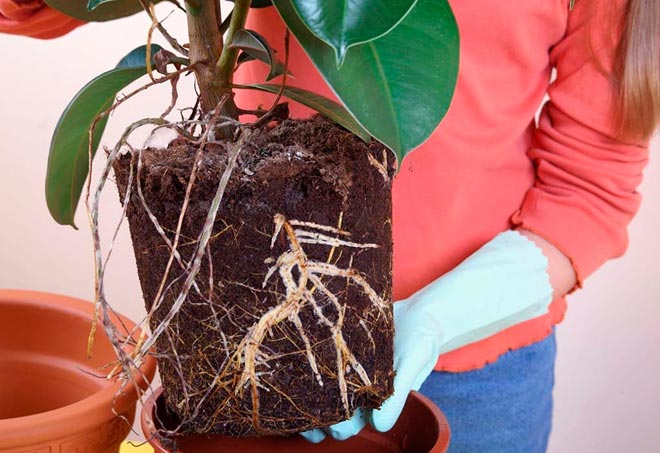

Despite the wide popularity of ficus as a home plant, high-quality care for it requires knowledge about the features of its development. It is not difficult to follow the rules for handling the plant, in response, the flower will give the owners beautiful and lush greenery at any time of the year.
How to choose a new pot and how often can you replant
The indoor tree does not tolerate the change of soil and pot. Culture can be severely weakened and slow down development. In rare cases, death occurs. In order to prevent the consequences, the hostess needs to keep control over the frequency of transplants, which depends on the age of the tree:
- the youngest plants need a regular annual procedure;
- after 5 years of life, it can be seated once every 20 months;
- the most mature ficuses do not need replanting, they need regular renewal of the soil layer at the top.
Don't forget! Do not transplant without good reason. Only pests and roots rotting from waterlogging can cause it.
Pots 3 centimeters larger than the previous one are suitable as new housing. The choice often falls on such "houses":
- Plastic pots. Practical, easy to use and comfortable.
- Clay pots. Here, the plant will definitely not be waterlogged. Clay perfectly absorbs moisture.
- Wooden tubs. Used for transplanting small trees that have reached a decent size.
The right transplant site contributes to the good life of any indoor plant. Before buying, it is necessary to process and check the bottom for the presence of special holes for airing the soil. There are often cases when a flower pot breaks or a tree begins to lose its vitality. Unscrupulous vase manufacturers use cheap plastic to save money. Such material releases toxins upon contact with ground and water, poisoning the ficus. As a result, the plant begins to wilt. It is necessary to replace and correctly select a new container for the life of Benjamin's ficus.
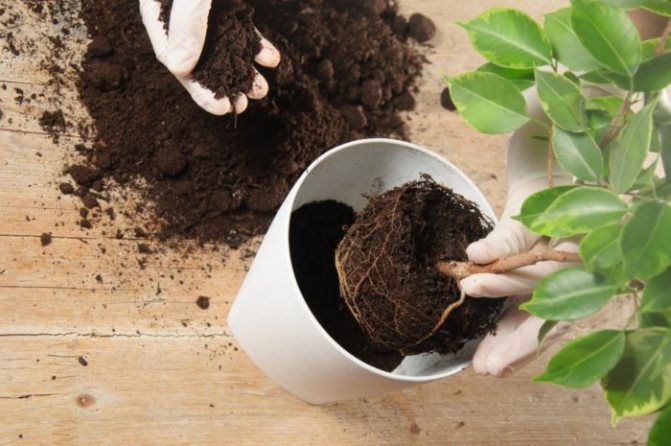

transplanting ficus benjamin into a larger pot
Many years of experience gives florists the ability to identify quality flower pots from low-quality ones. Familiar manufacturing companies provide quality plastic products. When choosing a new pot, you need to build on previous experience.
If the ficus has not taken root in a plastic pot, then it is better to use ceramics - it is natural, does not emit toxins, is beautiful and reliable. The material is not cheap, but it gives a one hundred percent guarantee of quality. In size, the new container should be as similar as possible to the old one, otherwise the plant will experience even more stress during transplantation.
Choosing a color is an equally important aspect. Experienced flower growers recommend choosing vases of bright and light colors. They will delight the eye at any time of the year and will attract the attention of guests. The right choice is the key to the comfort of a green tree.
Preparing for transplant
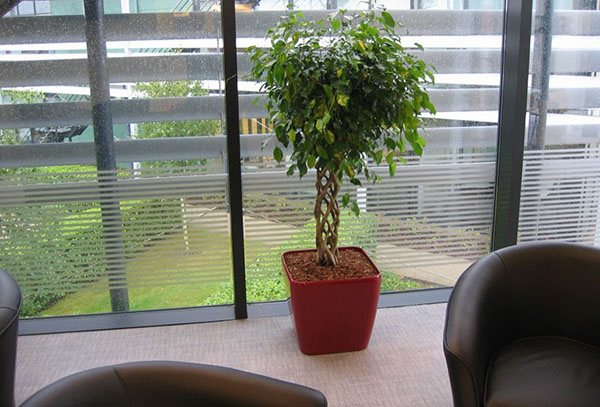

The vital activity of the plant depends on the useful and nutrient substances contained in the soil; for each flower you need to prepare its own composition of the substrate. Novice gardeners, in order not to doubt the correctness of the choice made, can purchase a container and soil immediately in the store.
Ficus is very sensitive to soil acidity, and if it is higher or lower than pH 5.5 -6.5, the plant will be less able to absorb nutrients and trace elements. This can affect its decorative effect.This is why it is so important to stick to one acidity reading for every plant transplant.
Pot selection
You do not need to buy a large pot right away, thinking that it will be "in reserve", you should choose a suitable container. Ficus "Benjamin" grows poorly in the same way: in tightness and space.
The best option would be a container in diameter and height 3 cm larger than the previous one. The bottom in it must necessarily have through holes, it is better to immediately buy a pallet for it, into which excess water will drain after watering. In the absence of holes, the water will stagnate in the pot and this will eventually lead to rotting of the plant roots.
The material of the pot can be varied: ceramic, clay, plastic. The first two types are preferable, since their walls absorb moisture well, but when rearranged or transported, they are inconvenient due to their heavy weight. Plastic options are attractive for their numerous assortment and unusual colors.
What kind of soil is needed?
When buying a soil mixture, the best option would be a soil with a neutral acidity index.
Self-preparation of the substrate is as follows:
- prepare all the components: sand (it is better to take its river form), leaf and sod land, peat;
- mix two parts of the earth, add one part of sand and peat to it;
- water the prepared soil mixture with diluted potassium permanganate or hot water to prevent contamination of the soil with pathogenic organisms, and if they are in the ground, then such measures will eliminate them.
A water procedure for the soil is mandatory, it is not only used for disinfection, but also contributes to the rapid adaptation of the plant in it.
How to transplant ficus at home step by step
To transplant a tree, the hostesses follow these instructions:
- The previous vessel is tapped so that the old earth no longer sticks to the walls of the vessel.
- In order not to spend a lot of time cleaning, you need to cover the place for transplanting with cardboard, unnecessary waste paper.
- Preparation of items for the procedure: pre-prepared soil, a small watering can, a plastic spatula and a new vessel.
- A drainage layer is poured onto the bottom of the new container. The thickness should vary by 3-5 cm - depending on the size of the pot.
- Remove the tree from the old vessel without removing the lump from the ground. Then they are moved to a more spacious dwelling.
- New fresh soil is poured around the entire circumference.
- The soil is compacted.
- After transplanting, watered or sprayed with water.


when and how to transplant benjamin ficus
Important! If the root system has been damaged due to improper tree care, then the roots must be completely cleaned of old soil and the damaged areas removed. The cut areas must be powdered with charcoal.
Transplant method
The ficus tree is transplanted by the transshipment method. This approach allows you to preserve the root ball and the roots of the plant themselves. There are no particular difficulties in this procedure, except that when working with a large plant, you will have to use someone's help. The transplant sequence is as follows:
- From the container in which the ficus is located, carefully remove the top layer of soil, trying not to damage the roots.
- Holding the plant by the trunk, it is loosened from side to side, separating the lump from the walls of the pot. In the case of a plastic container, if it is not too thick, the walls are crushed with hands from the outside.
- The root ball is removed from the pot, while continuing to hold the ficus by the trunk.
- Carefully examine the root system of the plant, cutting off any damaged tips found.
- A drainage layer is placed in the tub selected for planting.
- A purchased or self-made soil mixture is poured over the drainage.
- In the middle of the container, make a small depression in the ground and pour some water into it.
- The root ball is placed in the center of the tub, filling it with soil mixture along the edges and compacting the surface with your hands.
Important! The top layer above the root system should not be made too thick, since the deepening of the root collar can adversely affect the crown of the plant.
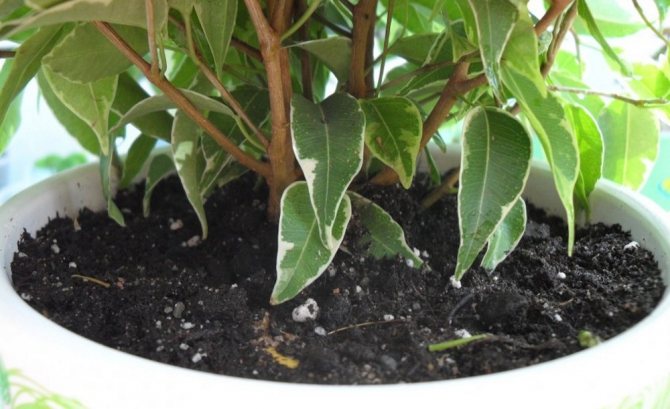

Soil surface after planting ficus
Care and watering of ficus Benjamin after transplant
After completing the procedure, the plant may begin to shed its leaves, but you should not be afraid of this, as this is a natural reaction to the stress experienced. Soon the tree will grow and develop fully again. If you overfill the soil with water, then soon the roots will begin to rot, and the tree may die from moisture.
After the transplant procedure, it is recommended to water a little. The first spraying with water should be carried out within two days. The main signal for watering is dry soil in a pot. A wooden stick is placed inside the container and pulled out. The stick was left without particles of earth - watering is required. If there are sticky pieces left, then you can and should wait for a few days.
Ficus is a capricious plant, it is difficult to tolerate a change in location. For a plant, it is better to choose a sunny, windless place. Can be placed in a corner where the sun shines in the morning, and closer to noon - a shadow.
How to care after transplant
After the procedure, the intensity of soil moisture is reduced by giving up watering for 1-2 weeks. Only the air around the flower and the leaves are moistened by spraying. The temperature regime is maintained within + 20-25 ° С. It is better to make the light in the room dim or use special phytolamps.
After 2 weeks, you can gradually increase the light level and resume watering. It is better to apply the first fertilizers after the procedure after 6 weeks, strictly observing the dosage.
Important! The period of adaptation of ficus to a new container lasts 1
–
2 weeks. During this time, the plant can shed a few leaves - this is a natural process, so nothing needs to be done.
When to transplant into a large pot
One has to think about choosing a new home for the tree when the root system begins to sprout out of the drainage holes. Sometimes roots can be seen on the surface of the soil layer. There is also a need for a transplant when the tree grows in an uncomfortable, small transport pot. It is impossible to grow and develop normally while being constrained.
It is also necessary to transplant a tree into a large pot when there is a need for reproduction in order to get new young plants. These factors indicate that the time has come to transplant a green tree into a large pot.
Frequent problems
Falling leaves
This is the most common problem, it is provoked by several reasons:
- Insufficient or excessive watering;
- Changes in humidity and temperature;
- Bad light;
- Change of scenery, moving;
- Low temperature or draft.
If you follow all the conditions for keeping ficus Benjamin, then leaf fall can be avoided.
Changing the shape of the color of the leaves
The color of the foliage will tell you what a ficus needs for good growth:
- Pale and yellowed say that the plant does not have enough light. In the summer, you can put the bowl closer to the window; in the winter, you need to add artificial lighting.
- Brown spots indicate sunburn, so it is better to rearrange the plant in the shade or under scattered rays.
- If the leaves withercurl and fall off, the plant lacks heat.
- The tips of the leaves dry and turn brown. - this is a signal about a lack of humidity in the room.
- White bloom indicates that the plant was watered with unboiled or unsteady water.
Pests
Spider mite
With insufficient humidity and high temperatures, unexpected guests may appear: scabbard, mealybug, aphid or spider mite... If spots, a sticky film or a cobweb began to appear on the leaves, then a pest has started.When fighting aphids or mites, it is enough to spray or wipe the crown with soapy water. You need to get rid of other parasites with special means.
Another common problem is decay of the root system... In this situation, it is necessary to repot the plant and remove all root rot. The cause of this trouble is excessive watering.
Ficus is a symbol of home warmth and comfort. The variety of its varieties is able to create harmony and style in any room. Proper care and attention will help make Benjamin's ficus a decoration of any interior.
Transplanting ficus Benjamin in the fall
There are emergencies when a tree grows in a poor substrate, often dries up or the soil is too dense. It is not recommended to transplant in the fall. In the period from October to the end of winter, the plant goes into a dormant stage. In order not to bother him once again, the procedure must be performed exclusively by the pass method.


benjamin ficus transplant
The worst option - during the dormant period, the roots of the tree began to rot or an attack of a nematode began. You cannot do without a full-fledged transplant. In such cases, you need to completely process the damaged roots with potassium permanganate and be patient. Transplanting needs to be done twice as carefully, once again without disturbing the roots. Sometimes the plant begins to shed its leaves, wither and slow down development. Due to damage to the root system, there are inevitable deaths.
Important! Root decay during a calm period can lead to the death of the flower.
Transferring from the shipping pot after purchase
A newly purchased ficus cannot be transplanted immediately, especially in winter, however, you should not delay with this. The procedure will be optimal in 2-3 weeks, after the plant appears in the house, when it has adapted to new conditions. At the same time, the transplanting rules are followed by the same ones that apply to moving the plant into a larger pot.
Having acquired several young Benjamin ficuses (up to 1 year old), you can resort to the following decorative technique: plant them all in one common large tub and weave still thin, flexible trunks.
Important! With older plants, this will no longer work.
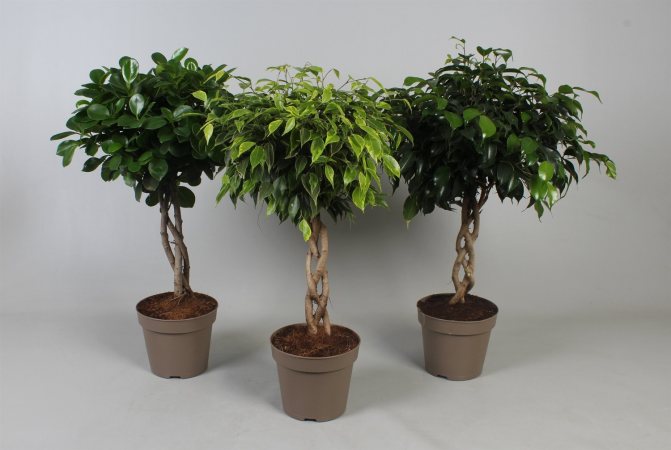

Benjamin's ficus with intertwined trunks
Why, after transplanting, Benjamin's ficus sheds leaves
Leaf shedding occurs for several reasons, but the root of the problem is always the same - improper care. Even a simple twist of the pot a few degrees to the left or right can generate a protest in the form of discarded leaves.
Change of location
Ficus is the same houseplant that can survive a transplant normally if handled correctly. But if you constantly rotate and move the pot, then the tree will not tolerate and will drop its leaves. Before transplanting, you need to carefully choose the place where the flower will be located. The temperature should be slightly higher than the average room temperature, and the lighting should be moderate. After the correct choice of "crossings" will be much less.
Excessive or insufficient lighting
Green crops are very sensitive to light. The tree will not like the shade or direct sunlight around the clock, and it will shed its foliage. In winter, it is good to provide additional light. The lamp should be placed 25-35 centimeters above the plant. A lamp up to 20 watts will suffice.
Improper watering
Most indoor plants do not like excess water in a pot, homemade ficus is no exception. Before transplanting, you need to take care of the correct thickness of the drainage layer, it should not exceed 5 centimeters. Watering should be done only on dry soil.
The reason for the leaves falling off is a lack of moisture. Because of this, the home flower tree cannot take nutrients, photosynthesize normally and move cell sap. In hot seasons, watering is necessary more often, in cold seasons - less often.
Little trick! A device with a sharp tip can loosen the topsoil without touching the roots. The earth will not dry out, Benjamin's ficus will receive a sufficient amount of moisture until the next watering.
General points of tree care
If the florist has a dilemma of how to transplant Benjamin's ficus, there is only one solution: to look for additional information. It should be noted that after performing the necessary maneuvers, this plant needs well-organized care. Initially, he is placed in a replaced room for a couple of days. This is necessary for the root system to complete the adaptation faster. After the specified time has elapsed, the ficus is returned to where it was taken from.
Watering for the first time is allowed after 2-3 days. But in the future, it is not necessary to create an accurate irrigation schedule for the flower, if it can be seen that the earth is sufficiently dry. This indicates that it is time to add moisture to the soil.
One more point regarding care: the ficus does not like low temperatures, so you should make sure that the soil does not overcool or vice versa. Acceptable minimum - 15-16 ° С, maximum - 27-30 ° С. If the environment changes and exceeds the values, the plant will die.
A flower with a variegated color of leaves requires an increased level of illumination, monotonous species need more partial shade and some scattering of light. In summer, the crown is sprayed with boiled or purified water several times a week. This type of water does not leave white streaks on the plant, since it does not contain heavy chemical compounds and salts.
Follow-up care
After the stress associated with transplanting, the plant must get used to the new environment for some time, so it slows down its growth:
- An important condition for the successful painless survival of the plant after transplantation is the observance of the temperature regime in the room., which should be in the range of 22 - 25оС, and the humidity of the air in it, as well as the soil.
- At this time, watering should be reduced and carried out only after the top soil layer has dried.
- Spraying the leaves with warm water every day has a beneficial effect. This can be done in the morning and in the evening.
- Small plants can be covered with a plastic bag to retain moisture.remembering to air several times during the day.
- You can spray the plant with Epin, which is a good growth stimulant. He will help him to recover and not get sick after the transplant.
- It is recommended to start feeding ficus one month after transplanting. Fertilize a flower in spring and summer at least 2 times a month, alternating organic fertilizers with mineral additives. The following fertilizers are well suited for this: Palmyra;
- Ideal;
- Rainbow.
You can also use infusion of mullein and other organics.
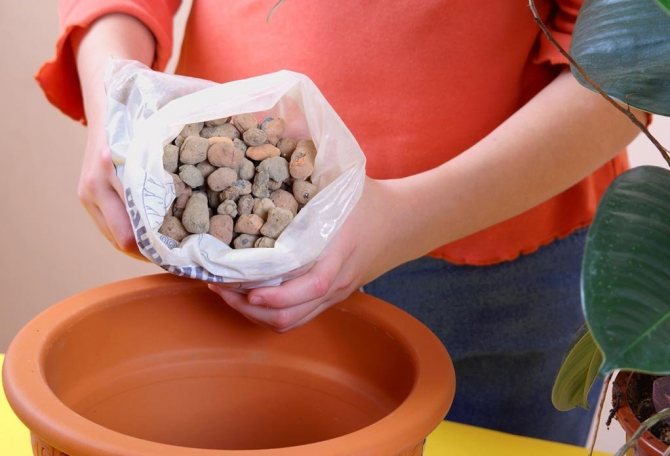

How to choose the time for a transplant
Many people think that transplanting ficus in a warm spring is the best time, but is it? To understand that it is time to transplant the ficus, you need to pay attention to the pot from which the roots of the plant begin to peep out, as well as to the peculiarities of the soil: it begins to dry out in the shortest possible period of time after watering. Another feature is the presence of root plexuses in the soil.
It is necessary to carry out a ficus transplant at home and taking into account the age of the flower. In the case when this is a young (up to 4 years old) plant, the transplant is carried out annually. More mature flowers need a more rare procedure: once every couple of years is enough. It is better if the transplant is carried out in late winter or early March. Speaking about transplanting in the fall, you should pay attention that this is not a suitable period at all. Some gardeners prefer to replant the flower in the summer at moderate temperatures.
Transplant features
Ficus needs to be transplanted after purchase.Since there are no conditions for long-term storage in stores, the plants are placed in special substrates to preserve their beautiful appearance, but the pot is chosen too small, the roots begin to braid the bottom and crawl out of the drainage hole.
The wrong type of watering, sunny or, conversely, a dark place can lead to deformation of the leaves, loss of a beautiful, healthy appearance.
The second reason for transplanting is the depletion of the soil, from which the roots absorb nutrients and moisture. The ficus stops growing. In addition, you should pay attention to the water for irrigation. The usual tap liquid is used, in which there are many different impurities and salts that negatively affect the state of the root system.
The third reason is a forced transplant:
- The pot is broken.
- The earth began to rot from excess moisture; the appearance of bacteria on the surface.
- There were suspicions of root decay and the appearance of pests.
Do not think that a transplant is an instant matter. Gardeners note that when the plant is pulled out of the pot, the root system can be damaged, the ficus simply cannot take root in the new conditions.
If the pot is plastic, then you can carefully cut the container and gradually pull out the plant. Before this, the ground must be watered so that the roots are protected from dryness in the room. It is imperative to pull the bottom out of the earthen coma so that the base of the plant has access to new nourished and useful soil. You can help yourself with a wooden, but not sharp, stick. With it, tap on clods of earth, gently extract the roots.
If the plant was watered often, then some roots could die off, they must be cut off, and the cut site must be treated with a protective substance. To see these roots, you need to rinse the base of the plant. Without cutting in a new pot with soil, the ficus will not be able to develop due to the defective functioning of the root system.
Transplanting indoor anthurium at home
After processing, the ficus is placed in a new pot, covered with soil, tamped and watered.
The right time


The best time for transplanting is early spring. During the winter, the plant hibernates, staying in a period of calm. This is marked by the cessation of growth, a slowdown in the processes of vegetation. At the beginning of spring, the root system begins to feed more actively, the growth process awakens. Ficus must be transplanted up to this point.
In summer, it is better not to touch the pot, since the roots are sensitive at this time and will not take root in the new soil. A ficus transplant in the fall is possible in case of urgent need. Over the summer, the plant can stretch so much that the roots will break through the drainage hole. For the transplant, a warm and sunny day must be chosen, the process itself must be carried out outside. The injured elements of the root system will be able to regenerate before the onset of cold weather.
In winter, a transplant is not recommended.
The frequency of transplanting ficuses depends on several factors:
- Height... Young seedlings grow quickly, therefore, they require an annual transplant, observing the basic rules for changing the soil and choosing a larger pot.
- Growing up period... When the ficus has already passed the active growth phase, it should be transplanted less often, approximately once every 2-3 years. The root system will not actively develop, so the pot can be selected of the same size, but additional feeds must be added to the soil so that the plant receives the necessary elements.
- Formation conditions... If the temperature, climate and location are suitable, then the ficus will develop quite quickly and transplantation in this case will be performed more often. If the conditions are not suitable, then the periods of calm will become long and there will be no need for frequent transplants.
Experts advise not to touch the soil of the ficus, so as not to disturb the periodicity of growth. If it is transplanted into a large pot, then it is not necessary to pull it out of there, it is enough just to change the topsoil. Do not forget about the regularity of watering, the rate of absorption of useful elements from the soil by the root system depends on it.
Preparatory stage
It is important not only to transplant, but also to select all the components for active growth. The main role is played by the pot, or rather the material from which it is made. Since ficus is a tropical plant, the roots should be warm. In autumn and winter, glass or ceramic pots will be cold for the plant, so plastic remains the best option. Of course, the view will suffer from this, but you can come up with an interesting planter, decorate it in accordance with the design of the apartment.
How best to prune indoor geraniums for the winter for recovery
Pots with automatic watering have become popular, which allows you to simply control the level of moisture in the soil, to add a glass of water into a special hole every two weeks.
The preparation process includes the following steps:
- Water abundantly before extraction. This will allow you to quickly and without damaging the root system, pull the plant out of the old pot. After that, the roots are thoroughly cleaned of the old soil.
- Preparing new dishes. Be sure to lay a drainage layer on the bottom, followed by a ball of soil. Ficus is installed in the center of the pot, then gradually the space between the roots and the walls of the dishes is filled with the prepared substrate. If there is fertilizer for the roots, then it must be thrown into the soil and mixed, only then filled with ficus. If you add liquid to water and just water the plant, there will be little effect.
- The level of backfill with soil should be the same as in the previous dish. If you throw the ficus higher, then the plant may hurt. No need to crush the ground ball by ball, just tap the sides of the pot. This will allow air to flow to the roots.
- The first watering should be done with boiled water at room temperature. You can soften the liquid by pre-freezing. Gardeners advise the liquid to first infuse for several days or filter using silicon. This will free her from lime.
- For irrigation, you can use melt or rainwater, it is soft, penetrates the roots faster.
Some time after watering, the liquid from the saucer must be drained so as not to over-saturate the roots. The next watering is carried out when the soil is completely dry. You can find out about this by sticking your finger in the ground.
It is not recommended to shift the irrigation schedule, it is advisable to carry it out in the morning or before lunch, when the plant needs feeding and its roots are in an active phase.
Preparing roses for wintering and methods of shelter for the winter in the Moscow region
Reproduction by shoots
Plant propagation by this method is best done during spring pruning. Thanks to the process, two tasks are carried out: shaping the mother plant, obtaining planting material.
Cuttings cut in spring are more likely to take root and take root. The shoot is chosen from the top of the plant, since all metabolic processes there are faster. The presence of semi-lignified shoots indicates that the selected element is completely healthy and develops normally.
For planting, a sprout of 12-15 centimeters with two internodes is suitable. The cut must be carried out with a sharp knife so as not to damage the surface of the plant. After cutting, the wound is sprinkled with crushed coal or rubbed with soil.
Be sure to rinse the cuttings under running water to rid the base of milk juice. If this is not done, a film will form on the cut surface, which will interfere with the normal development of the root system.
As for the leaves, they can also be cut off or, if the plant is large-leaved, left.
Rooting options:
- In water. The stalk is placed in a liquid, the leaves must remain on the surface so that the decay process does not begin, as the water decreases, it must be topped up. To control moisture evaporation, you can use a regular plastic bag placed over the plant. After a while, roots will appear. The plant can then be planted in a separate pot.
- In the ground. To do this, it is first disinfected with potassium permanganate, then a mixture is made of 1 part of peat, part of sand and half of vermiculite. Everything is mixed and allowed to brew for several hours. Gardeners are advised to do the procedure a few days before planting, so that the soil has time to be saturated with nutrients. It is imperative for the ficus in this case to make a greenhouse in order to activate the process of rapid growth.
To obtain the necessary temperature conditions, it is imperative to open the greenhouse several times a day and let in fresh air. You can buy a special heated rug, place the plant in a light and warm part of the house. These are the optimal conditions for the normal development of the appendix.
Violet care at home
Ficus soil
Many, without further ado, buy ready-made soil in the store and transplant it into it. This approach is not always justified, since often in the package, apart from low-lying peat and additives that are unnecessary for the plant, there is nothing useful. The presence of sand, for example, impairs the air permeability of the soil and prevents the root system from absorbing water.
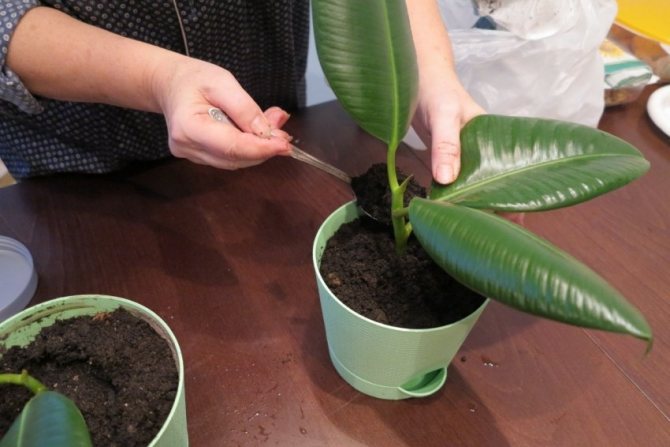

The best soil option for ficus is a mixture of the following components in approximately equal proportions:
- turf;
- very fine crushed stone;
- garden black soil;
- horse manure or compost;
- high-moor peat.
Read here Ficus turns yellow - what to do? The main reasons, tips for the restoration and treatment of indoor ficuses (110 photos and videos)


The mixture is thoroughly mixed and disinfected. It is undesirable to take sod near roads and in urban areas; it is better to take it in a forest or in a park area.



